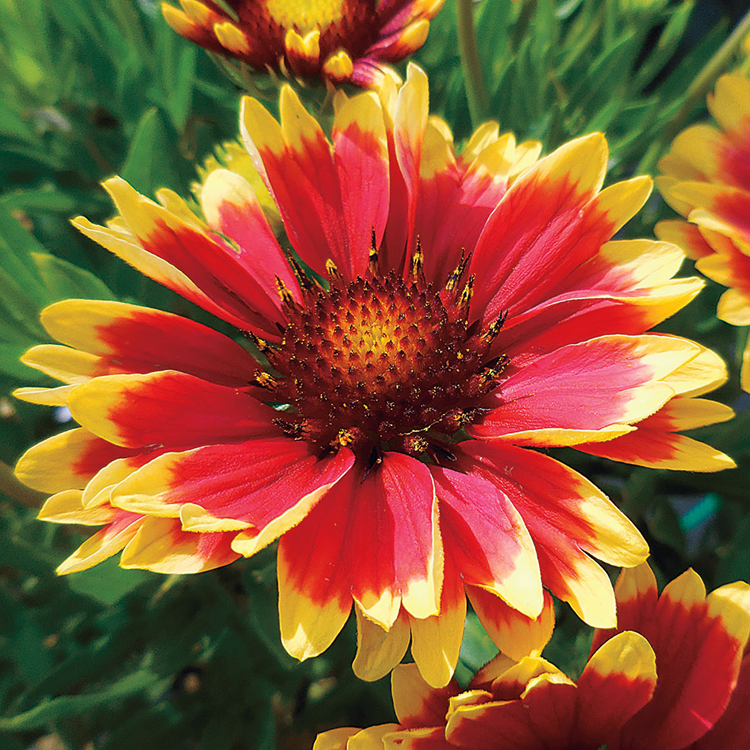Plant Selection Tips for the High Desert Garden
Unfortunately not every beautiful perennial you yearn for will thrive in a high desert garden. You can certainly go ahead and try those gorgeous begonias but be prepared for disappointment. While this is definitely the case there are many plants that will be more than happy and reward you with color and texture.
If you crave some of those shade lovers or plants so delicate that the high desert wind will pulverize them consider finding a sheltered spot for a beautiful pot or hanging basket. While I too love caladium, ferns and ranunculus it is best to save those for protected and shadier spots on the patio.
Tip #1
Every tag included with a plant will specify the type of sun that it needs. (And if there is no tag as is often the case – google it!)
Part sun means part sun! Unless you have an area that is truly part shaded – especially in the afternoon – most plants designated for part sun will fry in your garden. You might have success putting these in the shade of trees or bushes but as a rule stick only with those plants that say they like/need/can tolerate full sun. I have made this mistake in the past only to watch as they wilt and shrivel due to too much sun.
For information on my favorite high desert plants see my

Tip #2
 We all want our gardens to be as full of blooms as quickly as possible. It is very tempting – especially when first planting your beds – to want to buy lots and lots of plants in large pots.
We all want our gardens to be as full of blooms as quickly as possible. It is very tempting – especially when first planting your beds – to want to buy lots and lots of plants in large pots.
While there is nothing wrong with doing this a more circumspect approach can help your budget stretch farther. The fact is that if the correct plant is chosen it will grow quickly in the high desert garden. Before you know it your gaillardia will not only be a large lush plant in a short time it will be spreading and ready to divide.
My advice is to buy smaller pots for your beds. I get quite excited when I find perennials in 4 or 6 inch pots. I can then splurge and plant them in a grouping five instead of three; or even add several groupings in different beds. Gallon containers are pricey and it can even be difficult to dig a deep enough hole for them.
Note on Gallon Pots: Sometimes you can clearly tell that there are three distinct plants in one gallon pot. These can easily be split and planted.
Tip #3
Drought tolerant plants are good, but….
The terms drought tolerant and drought resistant are often used interchangeably—and incorrectly so. While drought-tolerant plants are able to grow or thrive with minimal water or rainfall, drought-resistant plants can survive for long periods of time without any water at all.
To add to the confusion of terminologies “water-wise” and “water-smart” refer to plants that grow well in a garden that manages water sensibly. (I wonder who defined “sensibly”?) There is also a difference between needing little water to survive and thriving when having small amounts of water on a regular basis. Also remember that established plants require less water than the newly planted.
How to know what can and cannot thrive with the same level of irrigation? Most drought resistant plants are in the cacti, succulent and native categories. If you choose to add these types of plants in your garden do not put them in the same beds with flowering perennials.
Monitor the health of your plants. Most people tend to overwater, especially when they see a plant wilting. Wilting on the contrary is a sign of overwatering. The difference is in the leaf: a plant with insufficient water will be crispy while the leaf of a plant with too much water will be moist. If you see signs of stress in a plant consider relocating it.
If you have beds that are not irrigated and must be hand watered consider the most drought tolerant plants in those locations – russian and texas sage, artemisia and red yucca, among others.

Tip #4
Consider supplementing your nursery plants with bulbs, corms, bare root plants and seeds.
To learn more about these see
Tip #5
Inspect your garden closely on a regular basis.
- Stick your finger down into the soil – make sure it is not too damp or hard as a rock. Adjust watering patterns or time if needed.
- Look for plants that are distressed and determine if it is a water issue, a pest issue or it’s just not happy in that place. While pests are rare in the high desert garden problems do occur – and are often brought in on the plant itself. Use organic treatments.
- Deadhead flowers on a regular basis to keep the blooms going. Cut flowers and bring them in the house!
- In the fall gather your seed heads, store them in paper lunch bags and sow them to expand your garden.
 Every once in a while I find one of these darn slugs in the soil. I have no idea where they come from – the plant, the compost, the mulch – ?? Just toss onto a hard surface and (yuck) squish!
Every once in a while I find one of these darn slugs in the soil. I have no idea where they come from – the plant, the compost, the mulch – ?? Just toss onto a hard surface and (yuck) squish!

0 Comments